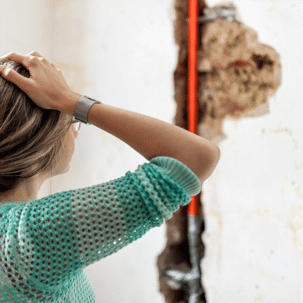Plumbing systems run like veins throughout our homes, often concealed behind walls, keeping our living spaces functional and comfortable. However, there are times when homeowners might need to locate these hidden pipelines, whether for renovations, repairs, or simply out of curiosity. In this comprehensive guide, we’ll walk you through various methods and tools to help you understand how to find plumbing in walls with ease and precision.
1. Using Stud Finders with AC Detection
Before you start any big changes in your home, you’ll want to know what’s inside your walls. That’s where stud finders with AC detection come in handy.
Why Is AC Detection Crucial in Stud Finders?
Stud finders equipped with AC detection are indispensable tools for homeowners keen on pinpointing the exact locations of plumbing lines in their walls. The AC detection capability enhances the tool’s ability to sense nearby electrical currents, which often run parallel to plumbing routes. The device’s intuitive interface usually highlights differences between stud edges, electrical wires, and potential pipe locations, simplifying the process of differentiating between them. Moreover, it offers peace of mind, ensuring homeowners avoid damaging pipes during renovations or installations.
2. Wall Scanners and Digital Detectors
When you need a detailed look into your walls, wall scanners and digital detectors are top choices.
The Evolution of Digital Wall Detection Technology
Wall scanners and digital detectors represent the cutting edge in home diagnostic tools. These devices, typically featuring screen displays, project a visual map of what lies behind the veil of your wall. Besides showing the skeletal stud structure, they can accurately locate plumbing and electrical conduits. While they may come at a higher price point than traditional stud finders, their precision and breadth of information make them invaluable for extensive renovation projects.
3. Infrared Cameras
If you’re curious about what’s hiding behind your walls, infrared cameras can show you without making a single hole.
How Infrared Technology Reveals Hidden Plumbing
Infrared cameras elevate your quest of how to see plumbing in walls to a whole new level. By capturing variations in temperature, these cameras can visually represent cooler or warmer spots behind a wall. Active plumbing, especially when water runs through them, tends to have a distinguishable temperature, making them easily visible on the infrared display. Furthermore, these cameras can help identify potential insulation gaps or electrical hotspots.
4. Non-Invasive Acoustic Tools
Hearing a wall might sound strange, but acoustic tools let you do just that. They help find plumbing by listening.
Listening to Your Walls
The principle behind acoustic tools is fascinating and efficient. These devices leverage the sound produced by water flowing through pipes, transforming it into audible cues. When a faucet is turned on, the consequent water flow produces a distinct sound pattern that these tools amplify, allowing homeowners to trace and locate plumbing paths behind walls. This method is not only non-invasive but also surprisingly accurate, making it a favorite for quick inspections.
5. Access Panels
Access panels, often found in modern homes or apartments, are specifically designed gateways to your home’s hidden systems. These panels, usually easy to remove, provide a direct visual pathway to plumbing and electrical setups. By leveraging these panels, homeowners can acquire a firsthand view of their plumbing’s condition and layout, assisting in any troubleshooting or modification plans.
6. Historical Blueprints or Home Plans
Delving into your home’s architectural history can yield much-needed insights. Original blueprints or home plans meticulously detail the intended paths for plumbing and electrical systems. Even though changes might occur post-construction, these documents remain a reliable starting point, offering a bird’s-eye view of the intended infrastructure.
7. Consult a Plumbing Professional
While tools and historical documents are handy, there’s no substitute for professional expertise. Plumbing experts come armed not just with advanced diagnostic tools, but years of experience that allow them to instinctively identify and address plumbing challenges. Their advice can shed light on the more complex aspects of how to locate plumbing in walls, making them invaluable for significant plumbing services like repair or renovation.
Frequently Asked Questions
How safe is it to drill into walls without checking for plumbing?
It’s risky to drill into walls without checking for plumbing. You might accidentally puncture a pipe, leading to leaks and potential water damage.
Can standard home tools help in detecting plumbing behind walls?
While some standard tools like stud finders can give hints about plumbing locations, specialized tools provide more accurate results.
Is there a risk of damaging pipes when using detection tools?
Most modern detection tools, like infrared cameras and acoustic detectors, are non-invasive and pose no risk to pipes. However, always follow manufacturer instructions and use caution.
Contact R.S. Andrews today
Navigating the intricate web of plumbing hidden within walls is a task that R.S. Andrews has mastered over the years, blending both advanced techniques and seasoned experience. Whether it’s utilizing cutting-edge tools, referencing past records, or tapping into our team’s vast knowledge, homeowners can rest assured they’re in capable hands. Gaining insight into your home’s plumbing layout not only paves the way for seamless renovations but also fortifies the dwelling’s structural well-being and promises optimal plumbing performance. Contact R.S. Andrews today to unravel the mysteries behind your walls.

